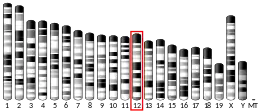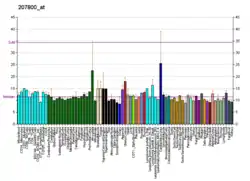AKAP5
A-kinase anchor protein 5 is a protein that in humans is encoded by the AKAP5 gene.[5][6][7]
Function
The A-kinase anchor proteins (AKAPs) are a group of structurally diverse proteins, which have the common function of binding to the regulatory subunit of protein kinase A (PKA) and confining the holoenzyme to discrete locations within the cell. This gene is intronless and encodes a member of the AKAP family. The encoded protein binds to the RII-beta regulatory subunit of PKA, and also to protein kinase C and the phosphatase calcineurin. It is predominantly expressed in cerebral cortex and may anchor the PKA protein at postsynaptic densities (PSD) and be involved in the regulation of postsynaptic events. It is also expressed in T lymphocytes and may function to inhibit interleukin 2 transcription by disrupting calcineurin-dependent dephosphorylation of NFAT.[7]
References
- GRCh38: Ensembl release 89: ENSG00000179841 - Ensembl, May 2017
- GRCm38: Ensembl release 89: ENSMUSG00000021057 - Ensembl, May 2017
- "Human PubMed Reference:". National Center for Biotechnology Information, U.S. National Library of Medicine.
- "Mouse PubMed Reference:". National Center for Biotechnology Information, U.S. National Library of Medicine.
- Carr DW, Stofko-Hahn RE, Fraser ID, Cone RD, Scott JD (Sep 1992). "Localization of the cAMP-dependent protein kinase to the postsynaptic densities by A-kinase anchoring proteins. Characterization of AKAP 79". J Biol Chem. 267 (24): 16816–23. doi:10.1016/S0021-9258(18)41856-X. PMID 1512224.
- Carr DW, Hausken ZE, Fraser ID, Stofko-Hahn RE, Scott JD (Aug 1992). "Association of the type II cAMP-dependent protein kinase with a human thyroid RII-anchoring protein. Cloning and characterization of the RII-binding domain". J Biol Chem. 267 (19): 13376–82. doi:10.1016/S0021-9258(18)42221-1. PMID 1618839.
- "Entrez Gene: AKAP5 A kinase (PRKA) anchor protein 5".
- Kashishian A, Howard M, Loh C, Gallatin WM, Hoekstra MF, Lai Y (Oct 1998). "AKAP79 inhibits calcineurin through a site distinct from the immunophilin-binding region". J. Biol. Chem. 273 (42): 27412–9. doi:10.1074/jbc.273.42.27412. PMID 9765270.
- Brandon NJ, Jovanovic JN, Colledge M, Kittler JT, Brandon JM, Scott JD, Moss SJ (Jan 2003). "A-kinase anchoring protein 79/150 facilitates the phosphorylation of GABA(A) receptors by cAMP-dependent protein kinase via selective interaction with receptor beta subunits". Mol. Cell. Neurosci. 22 (1): 87–97. doi:10.1016/s1044-7431(02)00017-9. PMID 12595241. S2CID 6172436.
External links
- Human AKAP5 genome location and AKAP5 gene details page in the UCSC Genome Browser.
Further reading
- Lester LB, Scott JD (1997). "Anchoring and scaffold proteins for kinases and phosphatases". Recent Prog. Horm. Res. 52: 409–29, discussion 429–30. PMID 9238861.
- Michel JJ, Scott JD (2002). "AKAP mediated signal transduction". Annu. Rev. Pharmacol. Toxicol. 42: 235–57. doi:10.1146/annurev.pharmtox.42.083101.135801. PMID 11807172.
- Hirsch AH, Glantz SB, Li Y, et al. (1992). "Cloning and expression of an intron-less gene for AKAP 75, an anchor protein for the regulatory subunit of cAMP-dependent protein kinase II beta". J. Biol. Chem. 267 (4): 2131–4. doi:10.1016/S0021-9258(18)45852-8. PMID 1733921.
- Carr DW, Stofko-Hahn RE, Fraser ID, et al. (1991). "Interaction of the regulatory subunit (RII) of cAMP-dependent protein kinase with RII-anchoring proteins occurs through an amphipathic helix binding motif". J. Biol. Chem. 266 (22): 14188–92. doi:10.1016/S0021-9258(18)98665-5. PMID 1860836.
- Coghlan VM, Perrino BA, Howard M, et al. (1995). "Association of protein kinase A and protein phosphatase 2B with a common anchoring protein". Science. 267 (5194): 108–11. doi:10.1126/science.7528941. PMID 7528941.
- Glantz SB, Li Y, Rubin CS (1993). "Characterization of distinct tethering and intracellular targeting domains in AKAP75, a protein that links cAMP-dependent protein kinase II beta to the cytoskeleton". J. Biol. Chem. 268 (17): 12796–804. doi:10.1016/S0021-9258(18)31458-3. PMID 8509414.
- Faux MC, Scott JD (1997). "Regulation of the AKAP79-protein kinase C interaction by Ca2+/Calmodulin". J. Biol. Chem. 272 (27): 17038–44. doi:10.1074/jbc.272.27.17038. PMID 9202019.
- Kashishian A, Howard M, Loh C, et al. (1998). "AKAP79 inhibits calcineurin through a site distinct from the immunophilin-binding region". J. Biol. Chem. 273 (42): 27412–9. doi:10.1074/jbc.273.42.27412. PMID 9765270.
- Paolillo M, Feliciello A, Porcellini A, et al. (1999). "The type and the localization of cAMP-dependent protein kinase regulate transmission of cAMP signals to the nucleus in cortical and cerebellar granule cells". J. Biol. Chem. 274 (10): 6546–52. doi:10.1074/jbc.274.10.6546. PMID 10037748.
- Dodge KL, Carr DW, Sanborn BM (1999). "Protein kinase A anchoring to the myometrial plasma membrane is required for cyclic adenosine 3',5'-monophosphate regulation of phosphatidylinositide turnover". Endocrinology. 140 (11): 5165–70. doi:10.1210/endo.140.11.7133. PMID 10537145.
- Fraser ID, Cong M, Kim J, et al. (2000). "Assembly of an A kinase-anchoring protein-beta(2)-adrenergic receptor complex facilitates receptor phosphorylation and signaling". Curr. Biol. 10 (7): 409–12. doi:10.1016/S0960-9822(00)00419-X. PMID 10753752.
- Sík A, Gulácsi A, Lai Y, et al. (2000). "Localization of the A kinase anchoring protein AKAP79 in the human hippocampus". Eur. J. Neurosci. 12 (4): 1155–64. doi:10.1046/j.1460-9568.2000.00002.x. PMID 10762347. S2CID 40933732.
- Colledge M, Dean RA, Scott GK, et al. (2000). "Targeting of PKA to glutamate receptors through a MAGUK-AKAP complex". Neuron. 27 (1): 107–19. doi:10.1016/S0896-6273(00)00013-1. PMID 10939335.
- Indolfi C, Stabile E, Coppola C, et al. (2001). "Membrane-bound protein kinase A inhibits smooth muscle cell proliferation in vitro and in vivo by amplifying cAMP-protein kinase A signals". Circ. Res. 88 (3): 319–24. doi:10.1161/01.res.88.3.319. PMID 11179200.
- Dart C, Leyland ML (2001). "Targeting of an A kinase-anchoring protein, AKAP79, to an inwardly rectifying potassium channel, Kir2.1". J. Biol. Chem. 276 (23): 20499–505. doi:10.1074/jbc.M101425200. PMID 11287423.
- Xie G, Raufman JP (2001). "Association of protein kinase A with AKAP150 facilitates pepsinogen secretion from gastric chief cells". Am. J. Physiol. Gastrointest. Liver Physiol. 281 (4): G1051–8. doi:10.1152/ajpgi.2001.281.4.G1051. PMID 11557526. S2CID 20939022.




